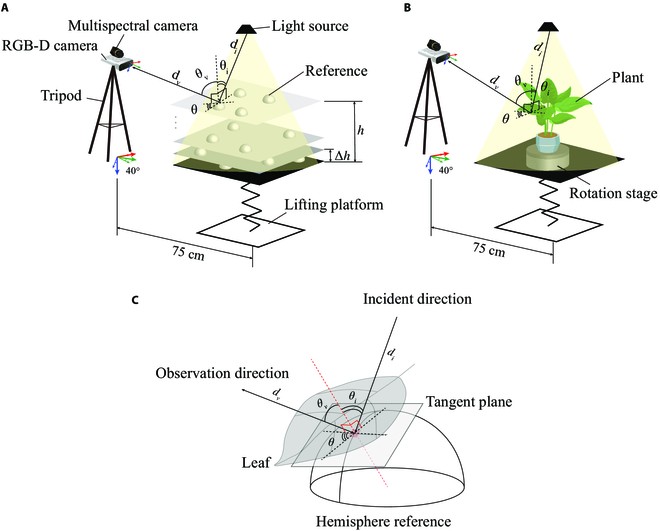Lifeasible has extensive experience and expertise in various fields, including agriculture, botany, ecology, and environmental science. Our high-resolution multispectral imaging equipment can acquire fine image data, which allows us to observe and analyze the microstructure and detailed features of plants and helps to reveal the growth patterns and phenotypic changes of plants. Our multispectral phenotypic imaging services can be widely used in different research fields to support crop improvement, ecosystem management, and environmental monitoring.
 Figure 1. Experimental setup of the multispectral imaging system. (Xie et al., 2023)
Figure 1. Experimental setup of the multispectral imaging system. (Xie et al., 2023)
Multispectral phenotypic imaging is an imaging technique that utilizes spectral information from multiple discrete bands to acquire phenotypic features of plants or other organisms. It combines spectroscopy and image processing methods to provide detailed information about a plant's growth, health status, and physiological characteristics by measuring light reflection or absorption properties in different bands. Multispectral phenotypic imaging is typically performed using devices with multiple light sources and corresponding spectral sensors. These light sources can emit various bands of light while the spectral sensors sense and record the reflected spectrum from the plant or organism.
Lifeasible's multispectral imaging services provide high-quality multispectral imaging equipment and perform equipment configuration and calibration to ensure accurate spectral measurements and image acquisition. Our service team will use the multispectral imaging equipment to perform spectral image acquisition of the plant or organism. The acquired image data will be analyzed and processed to extract information about plant growth, health status, and physiological characteristics.
Sample pre-processing involves growing, culturing, or treating samples to ensure their health and consistency. Depending on the specific research purpose, appropriate pre-treatment is required, such as applying specific stress conditions or applying specific treatment agents.
Based on the multispectral data, we can calculate various physiological parameters such as chlorophyll content, vegetation index, water content, etc. These parameters can be used to assess the growth status, health condition, and environmental stress level of plants.
By measuring the light reflection characteristics of different bands, vegetation cover, and vegetation indices, such as Normalized Vegetation Index (NDVI), can be calculated to assess the growth status of plants and the degree of environmental stress.
Our multispectral imaging service can help detect and diagnose pests and diseases affecting plants. By analyzing features in multispectral images, we can identify infected areas of plants and provide relevant pest and disease diagnostic reports.
Lifeasible's multispectral imaging services offer professional consultation and support. Our researchers can provide customized solutions and advice to maximize the use of multispectral phenotypic imaging based on the client's research needs and goals.
Lifeasible can perform accurate quantitative analysis of multispectral data. Through spectral feature extraction, image processing, and data analysis, multispectral data can be transformed into meaningful quantitative results to help researchers evaluate plants. If you are interested in our imaging platform, get in touch with us. We can develop a suitable experimental program and data analysis strategy for you to ensure that you get satisfactory results and solutions.
Reference